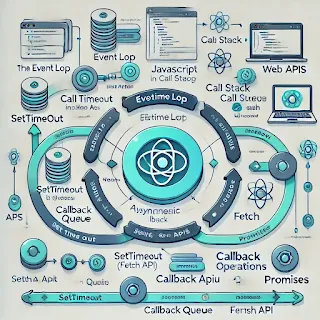1. Synchronous Programming
Definition
In synchronous programming, tasks are executed one at a time, in the order they appear in the code. Each task must complete before the next one begins.
Purpose
Synchronous programming ensures sequential execution, making it simpler to write and debug, especially for operations that rely on each other.
Uses
Simple scripts where tasks depend on the results of previous tasks.
Scripts that do not require multitasking or handling external resources like APIs.
Advantages
Easy to read and debug.
Predictable execution order.
Disadvantages
Blocks the main thread, causing delays in performance.
Not suitable for long-running operations like file I/O or API requests.
Example: Synchronous Programming
HTML:
html
<!DOCTYPE html>
<html lang="en">
<head>
<meta charset="UTF-8">
<meta name="viewport" content="width=device-width, initial-scale=1.0">
<title>Synchronous Example</title>
<style>
body { font-family: Arial, sans-serif; text-align: center; margin-top: 50px; }
#output { margin-top: 20px; color: green; font-weight: bold; }
</style>
</head>
<body>
<button onclick="runSync()">Run Synchronous Code</button>
<div id="output"></div>
<script src="sync.js"></script>
</body>
</html>
JavaScript (sync.js):
javascript
function runSync() {
const output = document.getElementById('output');
output.textContent = 'Processing...';
// Simulate a blocking task
for (let i = 0; i < 1e9; i++) {}
output.textContent = 'Task Completed!';
}
When you click the button, the browser will freeze momentarily while the blocking task is executed.
2. Asynchronous Programming
Definition
In asynchronous programming, tasks are initiated and executed independently, allowing the program to continue running without waiting for the task to complete.
Purpose
To handle long-running operations without blocking the main thread, improving responsiveness and performance.
Uses
Fetching data from an API.
Handling file uploads or downloads.
Performing animations or user interface updates.
Advantages
Improves performance by allowing multitasking.
Prevents blocking the main thread, keeping the application responsive.
Disadvantages
Harder to write and debug due to callback complexity.
Can lead to issues like "callback hell" without proper handling.
Example: Asynchronous Programming
HTML:
html
<!DOCTYPE html>
<html lang="en">
<head>
<meta charset="UTF-8">
<meta name="viewport" content="width=device-width, initial-scale=1.0">
<title>Asynchronous Example</title>
<style>
body { font-family: Arial, sans-serif; text-align: center; margin-top: 50px; }
#output { margin-top: 20px; color: blue; font-weight: bold; }
</style>
</head>
<body>
<button onclick="runAsync()">Run Asynchronous Code</button>
<div id="output"></div>
<script src="async.js"></script>
</body>
</html>
JavaScript (async.js):
javascript
function runAsync() {
const output = document.getElementById('output');
output.textContent = 'Fetching data...';
// Simulate an asynchronous task using setTimeout
setTimeout(() => {
output.textContent = 'Data fetched successfully!';
}, 2000); // Waits for 2 seconds without blocking
}
When you click the button, the message "Fetching data..." will appear immediately, and after 2 seconds, it will update to "Data fetched successfully!"
3. Comparison Table
4. Use Cases
Synchronous Use Cases
Mathematical computations or data processing.
Scripts where operations must occur in sequence.
Asynchronous Use Cases
Fetching live data from a server (e.g., weather updates).
Loading images, videos, or large files.
Chat applications where real-time updates are required.
5. Benefits
Synchronous
Straightforward execution flow.
Easier debugging.
Asynchronous
Improves application responsiveness.
Allows handling multiple tasks concurrently.
6. Combining Both
Sometimes, synchronous and asynchronous methods are combined for efficient handling of tasks. Here’s an example:
Example: Fetching API Data
HTML:
html
<!DOCTYPE html>
<html lang="en">
<head>
<meta charset="UTF-8">
<meta name="viewport" content="width=device-width, initial-scale=1.0">
<title>Async with Fetch</title>
<style>
body { font-family: Arial, sans-serif; text-align: center; margin-top: 50px; }
#output { margin-top: 20px; color: purple; font-weight: bold; }
</style>
</head>
<body>
<button onclick="fetchData()">Fetch Data</button>
<div id="output"></div>
<script src="fetch.js"></script>
</body>
</html>
JavaScript (fetch.js):
javascript
async function fetchData() {
const output = document.getElementById('output');
output.textContent = 'Fetching data...';
try {
const response = await fetch('https://jsonplaceholder.typicode.com/posts/1');
const data = await response.json();
output.textContent = `Title: ${data.title}`;
} catch (error) {
output.textContent = 'Error fetching data!';
console.error(error);
}
}
This combines synchronous-like readability (await) with asynchronous execution.

